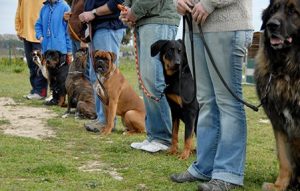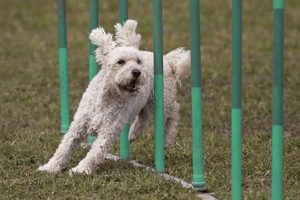Have You Trained Your Dog? Or Has Your Dog Trained You?
This post may contain affiliate links. If you make a purchase through these links, I will earn a commission at no extra cost to you. Thanks for reading!
INTRODUCTION
Is your dog so hard to control that you’re embarrassed to take him to the doggie park?
Do you dread having friends over for fear that your dog will bother your guests so much that they’ll never want to come back?
Or maybe you crack up every time your dog does something naughty. You know you shouldn’t laugh and enjoy seeing your pooch tearing apart a pillow, but you see how much fun he’s having. And perhaps down deep, you long for the pure bliss your dog is enjoying. You run for your camera to capture his fun digitally so you can show all your friends.
Won’t Training Break His Spirit?
Aversive training could break his spirit, but using positive reinforcement to train Fido will actually enhance his enjoyment of living with you.
Now you’re wondering what aversive training is. And even worse, you might be wondering if you’ve been doing it.
Aversive training involves negative reinforcement, such as –
- pulling harshly on your dog’s collar/leash
- reprimanding him in a harsh voice
- slapping him for misbehavior
There are many more negative tactics that are more extreme, but you get the idea, right?
Positive reinforcement, on the other hand, involves giving very small rewards for correct behavior, such as –
- giving him a very small treat
- petting him
- praising him
Obviously, there will be times when a stern voice from you or something even stronger is necessary. If you’re walking your dog and he jumps on an elderly lady, pulling on his leash may be the best solution for that moment – with the idea that you will address that poor behavior in future training sessions.
So, you can see that you may have to use negative methods from time to time. But studies have shown overall that dogs trained by negative reinforcement are more likely to exhibit stress-related behaviors, such as lowered body posture which can be a sign of fear.
Isn’t Training Difficult?
Training your dog isn’t as hard as you might think. And although you might be skeptical, it can actually be a lot of fun for both the dog and you.
You might not believe what you read in the last two sentences, but if you can put your skepticism aside for a while, you might see the value of spending time training your dog.
And once you understand the value, you might even be willing to commit to giving it a try – at least for a while. After all, only once you’ve gotten involved with training your dog can you decide whether –
- It isn’t as difficult as you thought.
- Your dog seems to get a lot of enjoyment from the activities and the time you spend together.
- You’re surprised at how much you look forward to spending time with your dog in the training sessions.
The end result will be that both you and your dog enjoy each other more. Dogs are amazing animals and have been enhancing the lives of people for thousands of years.

Remember though – they are free spirits who might not seem to want to be trained. Their natural instinct is to run wild, but they are very eager to please the humans they live with. You might not think your dog wants to please you, but engage in some positive reinforcement and you’ll find that he will do whatever he can to make you happy.
Be sure to include everyone in your household in training your dog. Dog training needs to be consistent. If some members of your family don’t follow the training guidelines, then your dog’s training will suffer.
If you have children, involving them in training the family dog will be a great education for them. Working together as a family can be a great project and a wonderful education for everyone.
What If You’re a Failure as a Trainer?
There could be many reasons why you don’t succeed in training your dog. Perhaps your job requires you to be away from home for long periods and the other family members don’t pick up the slack. Or maybe you find it impossible to be consistent.
If you’re having trouble training your dog, don’t give up. Look for a dog training course in your area and sign up for the next class for beginners.
Enlist another person in your family to take part in the course with you so that you’re both learning the techniques. If one of you becomes ill or unavailable for a session, the other person can fill in seamlessly. Just be sure that others in the household don’t undermine your dog’s progress.
Going to class with your dog involves commitment and dedication on your part, but the curriculum in a training class gives you and your dog an opportunity to learn and bond that you might not achieve on your own.
The rewards of training in a class can be immense. In addition to your dog learning to sit, stay, walk calmly on a leash, etc, the presence of other dogs will socialize your dog so that he behaves properly at the dog park.

Can’t I Hire a Professional Trainer?
The short answer is yes. You can hire someone to do the hard part for you. There are some drawbacks though.
- A professional trainer can be very expensive.
- You’ll need to be sure that the trainer is using methods that you approve of.
- You will need to participate at some point so that the training transfers to everyone in your home.
- You will miss the bonding that is a vital aspect of effective training. The relationship you develop with your dog during your training sessions can pay off far more than the ease you get by hiring a professional trainer.
So, read on to discover how you, your family, and your dog can benefit from training. And be prepared to find that your dog is an even more important part of your family than you ever thought.
1 – Training: The Benefits for Your Dog
Families throughout the world often bring a puppy into the home without considering all the responsibilities involved in owning a dog. They fell in love with a cute puppy and couldn’t resist bringing him home. Or their child begged to have a puppy, and they wanted to fulfill the child’s dream.
The responsibilities of owning a dog can include –
- getting the dog’s license
- feeding another family member
- providing treats, toys, and accessories like a collar and leash
- dog-proofing your home
- grooming
- giving regular exercise
- cleaning up the dog’s poop
- medical costs that can be huge
Most of all, having a dog means that you need to be willing to devote time to the new family member. People who haven’t seriously evaluated the responsibilities involved often get frustrated and end up dropping the unsuspecting pet at a shelter.
Training your dog is critical. He can still have a fun spirit, but he needs to know the boundaries that you set. If you take the time and make the effort to train your dog properly, he can be a wonderful and loving addition to your family instead of being a frustration or a nuisance.
Let’s take a look at some of the advantages to your dog once he has learned to be a member of the family.

Avoid Behavioral Issues
Just like humans, each dog has a unique personality with his own likes and dislikes. Your dog might hate something that your friend’s dog loves.
In addition, your dog could have a behavioral habit that you don’t like. Most behavioral issues can be altered with proper training. In particular, you’ll want to alter that behavior before it becomes too ingrained to change.
If you’re able to change the problematic behavior, your dog will become a more fully integrated and happy part of your family.
Improve Social Interaction
When you first bring a puppy or dog home, he won’t understand the routine of your household. He might become frightened when strangers come over to visit. And seeing strange dogs or other animals through the windows of your home could frighten your new pet and prompt him to start barking, jumping, or worse.
A trained dog will not need to resort to defensive behavior at the sight of strange animals or people. His training will have developed confidence in him so that he can judge threats realistically, thus making it possible for you and your dog to be around new people, places, and animals without problems.
Follow House Rules
Training your dog to follow the rules specifically set up for him will actually help him get along with the family as long as everyone adheres to those rules that Fido has to follow.
For example, if the rule is that your dog is not allowed to beg at the table, but some family members feed him scraps from the table, he’s likely to turn into a beggar.
And the inconsistency between family members can confuse him. Since food is involved, he’s likely to think that the person giving table scraps is the one to stick close to. But if he is then scolded by another family member for his begging behavior, he’ll have a difficult time trying to figure out where the boundaries are.
Training can help your dog understand when he can have something and when he can’t. Making sure that everyone in the house follows the same guidelines will mean that you don’t have to constantly reinforce the same training point.
Communicate Better
How well you and your dog get along and how well he fits into your family will be determined at least in part by how well you and your dog communicate with each other.
The two of you will learn how to communicate during the training process. He will learn the meaning of your gestures and the tone of your voice, and you will learn what your dog’s various vocalizations and movements mean.
Once you understand each other, you have a substantial foundation for future learning. After all, once you and your dog have finished basic training, you might want to teach him some tricks. And he might love learning more ways to please you.

Enjoy
Some people get a dog as a way to feel safe in their home. Yes, a dog that barks when he hears strange noises can deter potential robbers.
But most people get a dog for enjoyment. Not just enjoyment for the human, but for the dog as well. A dog that understands the rules and boundaries will enjoy himself within those parameters. And you will have the satisfaction and gratification of providing a home for your canine companion.
Keep Your Dog Safe
If you’re out walking your dog and he spots something enticing, like a squirrel or a cat way down the road, he might surprise you and want to take off running.
If you weren’t paying attention, he might be successful at getting away from you. That action could lead him into danger if he needs to cross a busy street to follow the target that lured him away.
If you’ve trained your dog on voice commands, you should be able to call him back to safety before he’s gotten very far.
You can probably imagine other scenarios that could put your dog in danger. But if you’ve trained him well, you’ll be able to prevent your companion from getting hurt.
2 – Training: The Benefits for You
So then, what about you? Caring for a dog is a substantial responsibility to take on. Will you really reap enough rewards to make it worth the effort?
Or will you find owning a dog too stressful?

That depends on you and the effort you’re willing to put into the endeavor. If you are willing to spend time learning about all the in’s and out’s of dog ownership, having a canine companion can be so rewarding that you’ll wonder why you didn’t do it sooner.
You’ve already seen how training your dog can make him happy. Can that same training benefit you and your family?
Let’s look at some of the benefits that training your dog can bring to you and your family.
Be Happier
After a bad day at work, there’s nothing that can lift your spirits more than a sloppy kiss from your doggie when you get home.
Yes, humans experience a lot of stress – at work, in traffic, with money, and more. It’s amazing, then, that a snuggle with your dog can often put a lot of that stress on the back burner.
And training your dog is an important aspect of reducing that stress. When you go to dog training class or even when you work on training your dog on your own, you get to see results of your efforts. And those results often come much more quickly than those in other parts of your life where you may have to work for much longer in order to accomplish your objective.
So, if you are someone who has a lot of stress, seeing the progress in training your dog can make you happy and can show you that your efforts can actually be rewarded.
Be Healthier
If you’re someone who works at a computer and leads a rather sedentary life in other ways as well, then training your dog will bring some activity into your daily routine.
Some types of training are more active than others, but even teaching your dog to fetch a ball means that you get out of your chair to go outside and throw the ball.
And who knows? You might even find that you enjoy time with your dog so much that you might decide to train him for agility. That training will get you both moving – and you’ll have a lot of fun besides.
Enjoy Home Life
Don’t expect your dog to start bringing your slippers to you. And he’s not going to do the dishes for you or vacuum the house. But a trained dog who understands his boundaries isn’t going to run around the house and chew everything in sight while you’re at work.
As a result, you’ll be able to come home from work and enjoy your dog’s companionship without the need to discipline him. You and he can go for a relaxing walk or just sit in front of the tv and watch your favorite series.

Be More Patient
Training your dog isn’t extremely difficult, but it takes some time and dedication from you. At first, you will just need to proceed on faith that training him will be worth it in the end.
You may have to dig deep inside yourself to find the patience you’ll need at the beginning stages, but eventually, you’ll notice some progress. Seeing that and feeling the rewards of helping another living being to master new skills can be very motivating.
You’ll find that the time it took was time well spent, and little by little, without even realizing it, you will likely develop more patience than you had before. You might not notice it in yourself, but someone who has known you for a while might make a comment about you being less stressed or more patient than before.
Be Realistic
People sometimes see a movie or read a book about a loyal dog who stuck by his owner who fell and lost consciousness – or a dog who waited every day outside the train station for his owner to return from work.
Then when the dog someone bought or rescued at a shelter doesn’t seem like that utterly loyal companion, the person becomes disillusioned with his pet.
First of all, that movie or that book probably grossly exaggerated the situation. Movies and books that describe mundane lives don’t sell very well. So, it’s important to realize that those situations are not the norm – don’t expect your dog to be the dog you’ve read about.
Even so, some attention and effort on your part can help turn your relationship with your dog into one that will please you both.
3 – Try Some Basic Training
This report is meant to explain some reasons why training your dog is important – not how to do it. But why not try to train your dog on some very basic commands on your own.
Here’s a list of the basic commands:
- Sit
- Stay
- Stop
- Stand
- No (To discourage wrong behavior)
- Fetch
- Heel (Used when walking your dog)
- Leave (To avoid conflict with other dogs)
You can probably understand what these commands are used for without any extensive explanation.
But did you know that you should only use these words during training? And they should be kept as single-word commands or in combination with your dog’s name – ‘Rex, SIT.’
Teach Your Dog to Sit
- Say the word ‘sit’ in a firm tone and commanding voice.
- Then, press firmly on the dog’s haunches, while pushing back on his chest at the same time. The dog will then be sitting.
- Give the dog a small treat and praise him in a pleasing tone – ‘Good boy, good boy.’
- Continue doing this until he obeys instantly. It might not happen during your first session. That’s okay. Work on it the next day.
Remember it’s a one-word command coupled only with the dog’s name. Use the dog’s name first to get his attention.
Some people make the mistake of using several words in a command because they don’t like the abrupt feeling of using just one word to command them to do something.
Instead, they use a pleading tone and say something like ‘Sit, boy’ or ‘Come on, sit.’ And you might be surprised that some people have been known to say something like ‘Be a good dog now and sit down.’
Don’t fall into that habit. Your dog will be confused and won’t understand what he’s supposed to do.
As already mentioned, the only other word to add is the dog’s name (to get his attention) before the command – ‘Rex, SIT.’ The message is clear and simple. Rex knows exactly what he’s supposed to do.

Follow the same process for the other commands as well. Master one command first before moving to the next.
Don’t try to teach several commands at one time since that would confuse the dog and interrupt his training.
If you’ve joined a dog training course, these tactics will be demonstrated. But you really can work on them at home on your own.
Remember, use the dog’s name and a single-word command, followed by a small treat and praise. And just be consistent.
Once your dog has these basic commands down pat, you can move to more advanced training if you like.
You could begin training your dog on agility training where you can train your dog to weave back and forth between poles, go through a tunnel, walk from one end a teeter-totter to the other end, and more.

Agility training can be lots of fun for your dog. He’ll love being able to please you more and more. And you can get a little exercise for yourself as well. Go to YouTube and check out some dog agility videos.
You can find lots of instructional books and DVDs online to help you learn the best ways to train your dog.
Conclusion
Hopefully, you now understand a little about some of the benefits both you and your dog will get from dog training.
Remember, it’s not just your dog who will benefit. Everyone in your family can participate and benefit.
Don’t forget that training a dog can have its up’s and down’s. Be patient, and make sure that anyone else who’s involved is following the plan and not expecting too much too soon. Some days might be hard. In fact, some days could be very difficult – especially at the beginning.
But you’ll reap the benefits in the end with a loving, loyal, and obedient dog who enjoys your company as much as you enjoy his.






